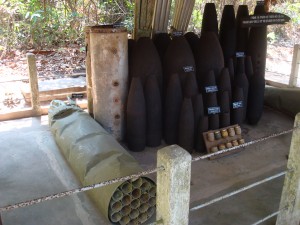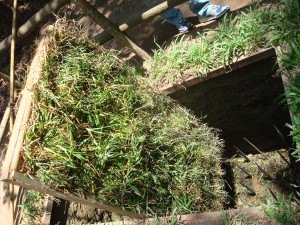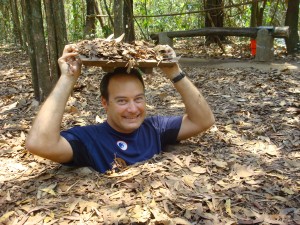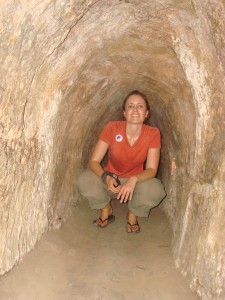
Recovered American munitions at Cu Chi tunnels: cluster bombs, landmines, missiles
Some family history: Mark’s dad, Don, served in the “American” war as a flight surgeon in 1970-71. He was a medical student finishing up at UCSF in the late 60’s and was given a choice: he could enlist and be allowed to finish school then serve in the Air Force as an officer and flight surgeon, or he would be drafted and enter without rank in an unknown branch. Needless to say, he enlisted and spent a year in Vietnam, mostly stationed at Cam Rahn Bay just south of Nha Trang. This trip was his first visit back to Vietnam in 40 years.
We hoped to see the old base and the beach where Don’s “hooch” (living quarters) was while in Nha Trang. Unfortunately, it wasn’t possible to see much as the Vietnamese military is now using most of the old U.S. base as an active submarine base. Also, most of the buildings present during the war have been bulldozed. However, a few recognizable pieces of the old base remained; the old military runway has been turned into the international airport for Nha Trang at Cam Rahn, and our Vietnam Airways flight to Nha Trang landed on the same strip of land Don landed on 40 years ago.
It was fun to fly in and see much of the old base as we circled to land. Once on the ground, we drove a small part of the loop that Don used to run while he was there, including passing an old church (now abandoned) that was on his route.
Traveling south gave us the chance to see an area preserved from the war – the Cu Chi Tunnels. At its height, this tunnel network stretched from the Cambodian border to Saigon. The Cu Chi district alone had more than 200 km of underground tunnels.
Our guide for the tunnels was a Viet Cong veteran. A Cu Chi native, he joined the effort at the age of 13 and helped dig tunnels. He has a shoulder injury from where he was shot in the back (probably by an American, but we didn’t ask).
He recounted that the Viet Cong would live in the tunnels for weeks at a time. There were underground first aid rooms, kitchens, sleeping rooms, weapon-making rooms, etc. He showed us a map of the Cu Chi Tunnel network, but made clear that no such map existed during the war (in fact, anyone who tried to make a map of the tunnels was immediately considered a spy). Nobody knew where all the tunnels went, as people in charge of one section of the tunnel would only know their piece.
We then walked the grounds and climbed through a couple tunnels. Jodi and Paul had visited the tunnels a few days before, and had warned us of bats. Luckily, ours were bat-free, though small. And hot. And dark. And smelly. We couldn’t imagine living in them for an hour, much less weeks! We were only in tunnels for *maybe* 10 minutes, and by the time we crawled out we were both drenched in sweat.
Another interesting part of the tunnel grounds were the reconstructions of booby traps. Several of the booby traps were created using refashioned pieces of American bombs. The Viet Cong and villagers would gather metal bomb fragments, and then hammer them into arrows, blades and other pain-inflicting tools.

A grass booby trap - step on it and be impaled on bamboo spears tipped with snake venom
What struck our party was how much energy and ingenuity went into figuring out ways to kill and maim others. The Americans dropped bombs, napalm, Agent Orange, and even dropped king cobras into the tunnels. The VCs stayed underground, used bomb pieces for new weapons, and ate the cobras (“Good protein!” said our guide).
Our guide left us with the wish that neither Vietnam nor America ever have to endure such a needless war again. Vietnam is at peace today and enjoying an economic boom. America is still working on it.


{ 3 comments… read them below or add one }
Allie, you did a great job summarizing our visit to the Cu Chi Tunnels. I was not looking forward to the visit but it was actually one of the highlights of Vietnam as I gained a new respect for the ingenuity of the Vietnamese guerillas who were the underdog in this war.
I think all political and military leaders who think of waging war should visit Cu Chi Tunnels or the Holocast Museum(s) or other such memorials.
We sure had fun getting to travel with you both. Thanks for the gift!
Allie, you certainly do listen well and remember well what I was talking about when I told of my experiences during the war. Thanks for highlighting what was a memorable experience.
Love, Donald
Thanks Donald – I am lucky to have an excellent editor and fact checker as a traveling partner. Mark is a huge part of every post, though he chooses not to publish under his account ;^)
We really enjoyed traveling with you and Ann as well, and look forward to swapping pictures next month.
Love,
Allie